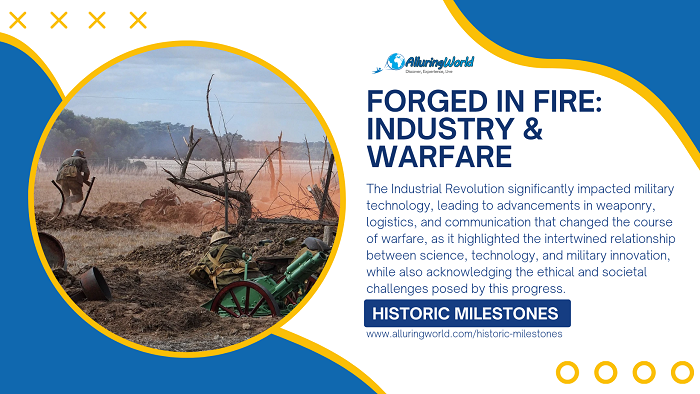Read time ca. 6 minutes
The synergy between science, technology, and military innovation has been a driving force in shaping modern warfare, and the Industrial Revolution marked a turning point in this relationship as it introduced advanced manufacturing, new materials, and groundbreaking inventions that revolutionized military capabilities. From the development of mechanized weaponry to enhanced communication systems, industrialization redefined how wars were fought and won.
The Shift to Mechanized Warfare:
Industrialization revolutionized weaponry as it transformed firearms into more accurate and lethal tools of war, and as the advent of rifling and percussion caps significantly increased the range and accuracy of rifles, while mass production enabled the arming of larger armies than ever before. This technological leap was further amplified by advancements in transportation, with steam-powered ships and railways revolutionizing logistics, as it allowed for the rapid movement of troops and supplies across vast distances where this newfound mobility and firepower dramatically altered the scale and intensity of warfare.
The mechanization of warfare brought about by industrialization had a profound and quite lasting impact on the battlefield where because of the increased range and accuracy of firearms it forced soldiers to seek cover and engage in trench warfare that unfortunately led to prolonged stalemates and devastating casualties. The sheer volume of firepower available to armies transformed battles into mechanized clashes of attrition, where the ability to sustain losses and maintain a steady supply of ammunition became paramount, so this shift in the nature of warfare had far-reaching consequences, shaping military strategy and tactics for generations to come.
The Role of Chemistry and Materials Science:
As the Industrial Revolution witnessed significant advancements in chemistry and materials science that profoundly impacted warfare, so the further inventions like the invention of smokeless powder revolutionized firearms and artillery by minimizing the telltale smoke clouds, allowing for more accurate targeting and reducing a soldier’s exposure. Simultaneously, breakthroughs in metallurgy led to the development of stronger and lighter materials which have enabled the construction of ironclad warships and more resilient weaponry, and these advancements not only increased the destructive potential of military hardware but also altered the very nature of naval combat.
Furthermore, the industrial era saw the rise of powerful explosives, and scientific research yielded compounds like dynamite and TNT, which proved invaluable in both construction and destruction. These explosives transformed the landscape of warfare which enabled the creation of more powerful and devastating weapons such as simple ones to high-explosive artillery shells and landmines as well. Sadly, this increased the destructive capacity and it had a profound and lasting impact on the battlefield as it reshaped military tactics and strategies.
Communication and Strategy:
As the advancements throughout the years and decades significantly improved, industrialization revolutionized military communication as well, transforming the way wars were fought. The invention of the telegraph enabled near-instantaneous communication over vast distances as it gave commanders unprecedented control over battlefield operations, and this allowed for rapid coordination of troop movements, the swift transmission of orders, and the timely sharing of critical intelligence.
Later innovations, such as radio technology, additionally enhanced battlefield communication, and radio allowed for real-time coordination between units, enabling commanders to direct operations with greater precision and speed. As this facilitated the development of complex maneuvers and coordinated attacks, it transformed the nature of warfare from a series of isolated engagements to a more fluid and interconnected system, and these advancements in communication played a pivotal role in modernizing military strategies and tactics, enabling the rise of modern warfare with its emphasis on speed, coordination, and centralized command.
The Birth of Modern War Machines:
Still, the late 19th and early 20th centuries witnessed the emergence of iconic war machines that redefined warfare across domains, and industrial capabilities which were fueled by advancements in engineering and manufacturing, enabled the creation of tanks, submarines, and aircraft. As tanks were initially developed during World War I, it has to be noted that they revolutionized land warfare by allowing troops to overcome entrenched positions and traverse difficult terrain. As submarines had the ability to operate undetected beneath the surface, they further transformed naval warfare as they introduced a new dimension of strategic and tactical advantage.
Furthermore, the advent of aircraft as well expanded the scope of warfare as they enabled aerial reconnaissance, bombing, and eventually, air-to-air combat, and these innovations were not merely technological feats but direct outcomes of the industrial revolution, simply demonstrating how scientific ingenuity and advanced manufacturing processes could be harnessed to create powerful instruments of war, fundamentally altering the balance of power on the global stage.
The Ethical and Societal Implications:
While industrialization undeniably advanced military technology, it also brought about profound ethical concerns and societal challenges because the increased destructiveness of war machines, such as from machine guns to tanks and aircraft, led to unprecedented levels of casualties during conflicts like the two World Wars from the 20th century. During these great wars, the very nature of warfare was transformed, and with industrialization, it enabled mass production of weapons and the mobilization of entire societies for the war effort. This raised serious questions about the morality of weapon development and the ethical implications of prioritizing resources for military purposes as great monetary means were diverted from social and economic needs, so the shadow of industrial warfare continues even today to loom large, prompting ongoing debates about the relationship between technology, progress, and the preservation of human life.
Conclusion:
In conclusion, the Industrial Revolution catalyzed a transformative era in military innovation, intertwining science, technology, and warfare where the advancements in weaponry, logistics, and communication not only reshaped how battles were fought but also highlighted the profound impact of industrialization on global conflict, and as military technology continues to evolve today, the lessons of the industrial era remain a critical reference point, emphasizing the dual-edged nature of progress in the realm of war.

